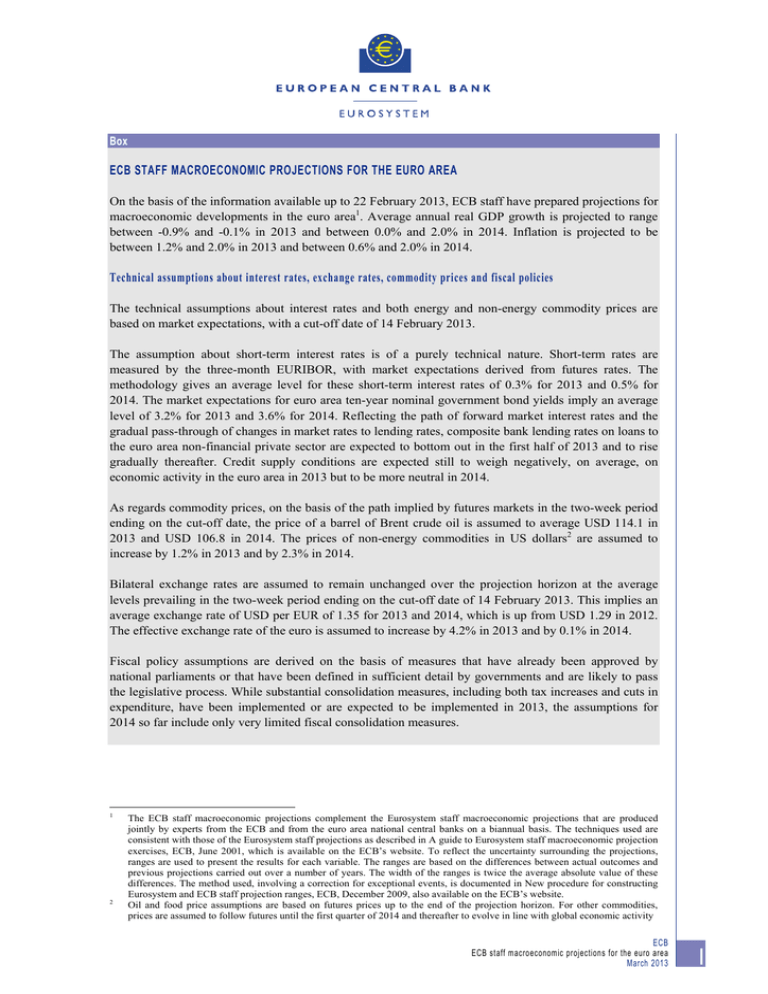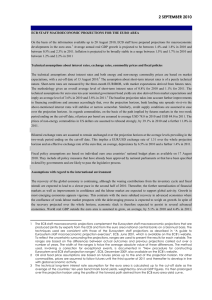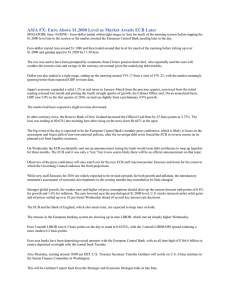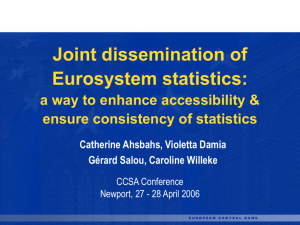ECB STAFF MACROECONOMIC PROJECTIONS FOR THE EURO AREA
advertisement

Box ECB STAFF MACROECONOMIC PROJECTIONS FOR THE EURO AREA On the basis of the information available up to 22 February 2013, ECB staff have prepared projections for macroeconomic developments in the euro area1. Average annual real GDP growth is projected to range between -0.9% and -0.1% in 2013 and between 0.0% and 2.0% in 2014. Inflation is projected to be between 1.2% and 2.0% in 2013 and between 0.6% and 2.0% in 2014. Technical assumptions about interest rates, exchange rates, commodity prices and fiscal policies The technical assumptions about interest rates and both energy and non-energy commodity prices are based on market expectations, with a cut-off date of 14 February 2013. The assumption about short-term interest rates is of a purely technical nature. Short-term rates are measured by the three-month EURIBOR, with market expectations derived from futures rates. The methodology gives an average level for these short-term interest rates of 0.3% for 2013 and 0.5% for 2014. The market expectations for euro area ten-year nominal government bond yields imply an average level of 3.2% for 2013 and 3.6% for 2014. Reflecting the path of forward market interest rates and the gradual pass-through of changes in market rates to lending rates, composite bank lending rates on loans to the euro area non-financial private sector are expected to bottom out in the first half of 2013 and to rise gradually thereafter. Credit supply conditions are expected still to weigh negatively, on average, on economic activity in the euro area in 2013 but to be more neutral in 2014. As regards commodity prices, on the basis of the path implied by futures markets in the two-week period ending on the cut-off date, the price of a barrel of Brent crude oil is assumed to average USD 114.1 in 2013 and USD 106.8 in 2014. The prices of non-energy commodities in US dollars2 are assumed to increase by 1.2% in 2013 and by 2.3% in 2014. Bilateral exchange rates are assumed to remain unchanged over the projection horizon at the average levels prevailing in the two-week period ending on the cut-off date of 14 February 2013. This implies an average exchange rate of USD per EUR of 1.35 for 2013 and 2014, which is up from USD 1.29 in 2012. The effective exchange rate of the euro is assumed to increase by 4.2% in 2013 and by 0.1% in 2014. Fiscal policy assumptions are derived on the basis of measures that have already been approved by national parliaments or that have been defined in sufficient detail by governments and are likely to pass the legislative process. While substantial consolidation measures, including both tax increases and cuts in expenditure, have been implemented or are expected to be implemented in 2013, the assumptions for 2014 so far include only very limited fiscal consolidation measures. 1 2 The ECB staff macroeconomic projections complement the Eurosystem staff macroeconomic projections that are produced jointly by experts from the ECB and from the euro area national central banks on a biannual basis. The techniques used are consistent with those of the Eurosystem staff projections as described in A guide to Eurosystem staff macroeconomic projection exercises, ECB, June 2001, which is available on the ECB’s website. To reflect the uncertainty surrounding the projections, ranges are used to present the results for each variable. The ranges are based on the differences between actual outcomes and previous projections carried out over a number of years. The width of the ranges is twice the average absolute value of these differences. The method used, involving a correction for exceptional events, is documented in New procedure for constructing Eurosystem and ECB staff projection ranges, ECB, December 2009, also available on the ECB’s website. Oil and food price assumptions are based on futures prices up to the end of the projection horizon. For other commodities, prices are assumed to follow futures until the first quarter of 2014 and thereafter to evolve in line with global economic activity ECB ECB staff macroeconomic projections for the euro area March 2013 1 Projections for the international environment World real GDP growth (excluding the euro area) is projected to pick up gradually over the projection horizon, rising slightly from 3.7% in 2012 to 3.8% in 2013 and further to 4.4% in 2014. The expectation of this gradual pick-up is backed up by PMI surveys (outside the euro area), which have risen towards their long-term averages in recent months, thereby signalling an improvement in business sentiment. In addition, global financial market conditions have improved further as evidenced by rising stock market prices, lower financial market volatility and the reduction of key financial market spreads. However, the medium-term outlook for the key advanced economies continues to be constrained. Notwithstanding the progress made in rebalancing private sector debt, the level of households’ indebtedness remains elevated in the advanced economies, while the need for tighter fiscal policies should dampen growth prospects in the coming years. At the same time, growth in emerging economies is projected to remain robust. Broadly in line with the global growth outlook, euro area foreign demand is expected to grow by 3.5% in 2013 and 6.3% in 2014, after 3.2% in 2012. Real GDP growth projections Euro area real GDP fell by 0.6% in the fourth quarter of 2012, following a decline of 0.1% in the third quarter and of 0.2% in the second quarter. Euro area domestic demand declined significantly in the fourth quarter of the year, with both private consumption and investment dropping. Exports also fell, reflecting the weakness of trade developments observed at the end of last year. Looking ahead, real GDP growth is expected to stabilise during the first half of the year and to recover gradually from the second half of 2013 onwards. In 2013, a gradual pick-up in export growth – supported by more favourable external demand developments, only partly offset by losses in competitiveness due to the strengthening of the euro – is likely to provide a positive stimulus to growth. The recovery is also expected to be supported by a favourable impact on domestic private demand of the accommodative monetary policy stance, as well as by the favourable impact on real disposable income of a decline in inflation, which in turn is driven partly by the appreciation of the euro and partly by the assumed weakening of commodity prices. However, the weakness of domestic demand, stemming from still overall low levels of sentiment and from the remaining deleveraging and fiscal consolidation needs in some countries, is expected to persist, with domestic demand recovering only gradually over the projection horizon. Overall, the projected recovery remains subdued by historical standards, resulting in a negative output gap over the whole projection horizon. In annual terms, real GDP is expected to grow by between -0.9% and -0.1% in 2013 and between 0.0% and 2.0% in 2014. Considering the demand components in more detail, extra-euro area export growth is projected to gain momentum during the course of 2013 and beyond. This outlook is supported by the gradual strengthening of euro area foreign demand, although it is projected to be partly moderated by losses in competitiveness on account of the strengthening of the euro. Business investment, after likely dropping in the last quarter of 2012, is projected to weaken somewhat further in the first half of 2013, owing to still relatively weak levels of sentiment, low capacity utilisation, fragile demand prospects and adverse credit supply conditions in some countries. Having reached historically very low levels, as a share of GDP, business investment is projected to pick up from the second half of 2013, supported by the gradual strengthening in domestic and external demand and by the very low level of interest rates. Residential investment is expected to decline further in the coming quarters as a result of weak growth in disposable income, still fragile and only tentatively recovering consumer sentiment and further adjustment needs in the housing markets in some countries. These adverse impacts are expected to more than offset the effect of the relative attractiveness of housing investment in some other countries, where residential investment is supported by historically low mortgage rates. Government investment is expected to decline throughout the projection horizon due to the expected fiscal consolidation measures in several euro area countries. 2 ECB ECB staff macroeconomic projections for the euro area March 2013 Private consumption fell in the fourth quarter of 2012. This likely reflected a sharp decrease in real disposable income, only partly offset by a decline in the saving ratio as households tried to smooth consumption. Private consumption is expected to decline further in the first half of 2013 and to recover mildly during the second half of the year, broadly reflecting the pattern of real disposable income growth. In 2014, private consumption growth is projected to gain momentum owing to a pick-up in labour income as labour market conditions improve and as the adverse impact of fiscal consolidation measures recedes. However, a rise in the saving ratio – reflecting persistently high unemployment rates and the need to reduce household indebtedness – is expected to dampen the recovery of private consumption in 2014. Government consumption is projected to decline in 2013 due to fiscal consolidation efforts and to increase modestly in 2014. Extra-euro area imports are projected to rebound from their recent weakness during the course of 2013 and beyond, reflecting the gradual recovery of total demand. With stronger growth in exports than in imports, net trade is expected to contribute positively to GDP growth over the projection horizon, although to a lesser extent than in 2012. The current account surplus is expected to increase over the projection horizon owing to an increasing trade surplus. Table A Macroeconomic projections for the euro area (average annual percentage changes)1) HICP 2012 2.5 2013 1.2 – 2.0 2014 0.6 – 2.0 Real GDP Private consumption Government consumption Gross fixed capital formation Exports (goods and services) Imports (goods and services) -0.5 -1.2 0.0 -4.0 2.9 -0.7 -0.9 – -0.1 -1.3 – -0.3 -0.9 – -0.1 -3.8 – -1.0 -1.3 – 3.5 -2.1 – 2.3 0.0 – 2.0 -0.3 – 1.5 -0.4 – 1.2 -0.9 – 3.5 0.8 – 7.8 1.0 – 7.2 1) The projections for real GDP and its components refer to working day-adjusted data. The projections for imports and exports include intra-euro area trade. Price and cost projections The headline HICP inflation rate, which in February 2013 stood at 1.8% according to Eurostat’s flash estimate, is expected to fall further in the course of 2013, following the projected strong decline in the annual rates of energy price inflation and, to a lesser extent, food price inflation, from the elevated levels reached in 2012. The projected drop in energy price inflation partly reflects downward base effects from the expected fading away of the impact of past increases in oil prices, as well as their assumed gradual decline over the projection horizon. Similarly, the projected decline in food price inflation reflects downward base effects, as the impact of past increases fades away, and the assumption that international and European food commodity prices ease somewhat over the projection horizon. HICP inflation excluding food and energy is projected to ease marginally in 2013, reflecting the appreciation of the euro and subdued economic developments. This measure of inflation is projected to edge up only slightly in 2014, reflecting the modest recovery of activity. In annual average terms, HICP inflation is projected to decline from 2.5% in 2012 to between 1.2% and 2.0% in 2013 and further to between 0.6% and 2.0% in 2014. ECB ECB staff macroeconomic projections for the euro area March 2013 3 In more detail, external price pressures have eased in recent months due to the appreciation of the euro. The annual growth rate of the import deflator is projected to fall in 2013, before stabilising slightly in 2014, as the downward impact of the stronger exchange rate of the euro is assumed to fade away. Turning to domestic price pressures, the annual growth rate of compensation per employee is expected to remain subdued in 2013 and 2014 on account of the weakness of the labour market situation. Taking into account the projected fall in consumer price inflation, real compensation per employee is projected to increase gradually over the projection horizon, following declines in 2011 and 2012. Unit labour cost growth is projected to remain relatively elevated in 2013, as productivity growth will be substantially weaker than wage growth. As productivity growth is expected to pick up in 2014, reflecting a faster recovery in activity than in employment, unit labour cost growth is expected to decline. The profit margin indicator, calculated as the ratio of the GDP deflator at basic prices to unit labour costs, is expected to fall somewhat further in 2013, following a stronger decline in 2012, compensating for the relatively strong increase in unit labour costs. Thereafter, lower unit labour cost growth and gradually improving economic conditions are expected to support a recovery in profit margins. As part of fiscal consolidation plans, increases in administered prices and indirect taxes are expected to make a relatively large contribution to HICP inflation in 2013 and in 2014, even if this consolidation is slightly smaller than in 2012. Comparison with the December 2012 staff projections Compared with the Eurosystem staff macroeconomic projections published in the December 2012 issue of the Monthly Bulletin, the upper end of the range for real GDP growth in the euro area for 2013 has been revised downwards. This revision mostly reflects the weak outcome of real GDP in the fourth quarter of 2012, which implies a mechanically more negative carry-over effect into the average annual growth rate for 2013. However, the quarterly growth profile for 2013 is broadly unrevised. The range for average annual real GDP growth in 2014 has been revised slightly downwards. With regard to HICP inflation, the projection range for 2013 is somewhat narrower. For 2014, the upper end of the range is slightly lower than in the December 2012 projection, mainly reflecting the impact of the stronger exchange rate of the euro. Table B Comparison with the December 2012 projections (average annual percentage changes) Real GDP – December 2012 Real GDP – March 2013 HICP – December 2012 HICP – March 2013 2013 -0.9 – 0.3 -0.9 – -0.1 2014 0.2 – 2.2 0.0 – 2.0 1.1 – 2.1 1.2 – 2.0 0.6 – 2.2 0.6 – 2.0 Comparison with forecasts by other institutions A number of forecasts for the euro area are available from both international organisations and private sector institutions (see Table C). However, these forecasts are not strictly comparable with one another or with the ECB staff macroeconomic projections, as they were finalised at different points in time. Additionally, they use different (partly unspecified) methods to derive assumptions for fiscal, financial and external variables, including oil and other commodity prices. Finally, there are differences in working day adjustment methods across different forecasts. 4 ECB ECB staff macroeconomic projections for the euro area March 2013 According to the forecasts currently available from other organisations and institutions, euro area real GDP growth is expected to range between -0.3% and 0.0% in 2013, which is close to the upper end of the range of the ECB staff projections. For 2014, available forecasts lie between 1.0% and 1.4%, which is within the range of the ECB staff projections. As regards inflation, available forecasts suggest that the average annual HICP inflation rate will be in a range between 1.6% and 1.9% in 2013 and between 1.2% and 1.8% in 2014, both of which are within the ranges of the ECB staff projections. Table C Comparison of forecasts for euro area real GDP growth and HICP inflation (average annual percentage changes) Date of release OECD European Commission IMF Survey of Professional Forecasters Consensus Economics Forecasts Euro Zone Barometer ECB staff projections November 2012 February 2013 January 2013 February 2013 February 2013 February 2013 March 2013 GDP growth 2013 2014 -0.1 1.3 -0.3 1.4 -0.2 1.0 0.0 1.1 -0.2 1.0 -0.1 1.2 -0.9 – -0.1 0.0 – 2.0 HICP inflation 2013 2014 1.6 1.2 1.8 1.5 1.6 1.4 1.8 1.8 1.8 1.7 1.9 1.8 1.2 – 2.0 0.6 – 2.0 Sources: European Commision Economic Forecasts, Winter 2013; IMF World Economic Outlook Update, January 2013, for real GDP growth and World Economic Outlook, October 2012, for inflation; OECD Economic Outlook, November 2012; Consensus Economics Forecasts; MJEconomics; and the ECB’s Survey of Professional Forecasters. Notes: The ECB staff macroeconomic projections and the OECD forecasts both report working day-adjusted annual growth rates, whereas the European Commission and the IMF report annual growth rates that are not adjusted for the number of working days per annum. Other forecasts do not specify whether they report working day-adjusted or non-working day-adjusted data. © European Central Bank, 2013 Address: Kaiserstrasse 29, 60311 Frankfurt am Main, Germany Postal address: Postfach 16 03 19, 60066 Frankfurt am Main, Germany Telephone: +49 69 1344 0 Fax: +49 69 1344 6000 Website: http://www.ecb.europa.eu All rights reserved. Reproduction for educational and non-commercial purpose is permitted provided that the source is acknowledged. ECB ECB staff macroeconomic projections for the euro area March 2013 5


